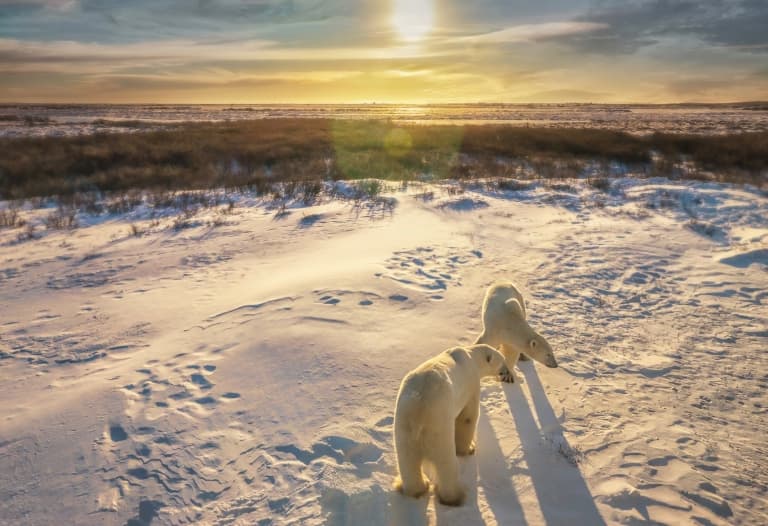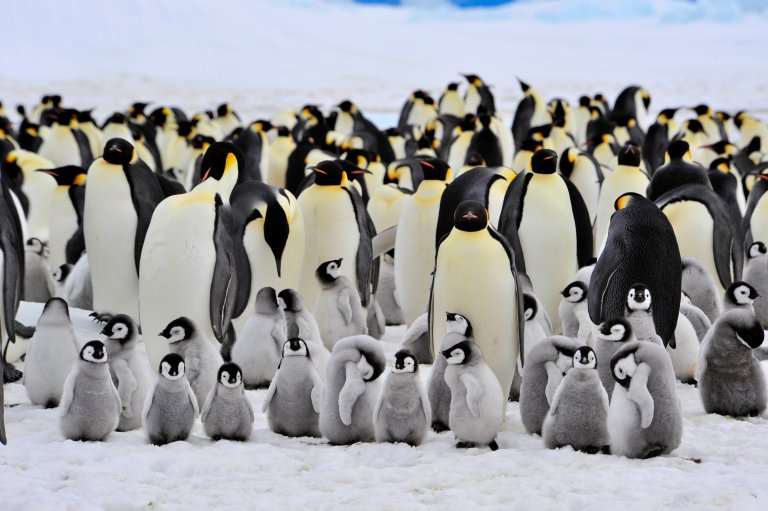The tundra is the coldest of all the biomes. It’s typically some of the driest, too, and for a large portion of the year, is covered in snow. Life is scarce here, and food is hard to come by.
But certain animals have figured out how to live, and even thrive, in the freezing polar regions, some even staying there year-round.
Yet, it’s no easy task, and these animals have had to sacrifice a lot to make it work.

Here, we’re going to look at ten good examples and explore some of the different options available to living in the tundra.
10. Arctic Fox
Arctic foxes are some of the fluffiest foxes you’ll see. This is for obvious reasons, but they have other adaptations to thrive in the frosty North.
Their bodies are compact and round, with small ears. Their noses are shorter than is normal for a fox, and their legs, too.

Keeping all of the sticky-outy bits as close to the centre of heat as possible is a common adaptation to the cold, and these little foxes have perfected it.
They also have thick fur on their feet, which is unusual for a fox, and this is where their species name lagopus (rabbit foot) comes from. 1
9. Arctic Lemming
There are two types of arctic lemming, both of which have evolved alongside one another since the very beginning of the Pleistocene. That’s given them plenty of time to get used to the cold, and despite following different genetic paths, they’ve both come to the same solutions to the problem independently.
The two species have convergently evolved powerful digging claws, thick teeth and huge guts, which allow them to eat low-quality roughage and not die.
The trouble with this solution is that it leaves little room for flexibility, and the lemming isn’t the most agile of animals in the face of danger. Still, in the high Arctic, they’re the only rodents tough enough to survive, so they must be doing something right. 2
8. Bison
In the Great Plains, Winter is severe. Most animals make themselves scarce to avoid freezing very much to death, but the bison is a stubborn beast and has instead chosen to adapt to it.
The ground freezes, wind picks up and temperatures plummet to below -20 Degrees Celsius, yet the well-equipped bison relies on its short legs, thick wool and powerful neck to comfortably scrape for food in the snow.

It’s not unusual to see bison with snow sitting on their coats all day long, demonstrating the insulating capabilities of its wool! Their huge heads act as a snow plough, allowing them to push through a meter or more of snow. 3
7. Arctic Hare
Arctic hares are all-terrain animals, with long legs and powerful high-stamina hearts. They can run up to 60 km/h if they have to, but they’d much prefer to rely on their exceptional camouflage and save energy.

Again, this animal draws in its appendages, with shorter ears, a smaller nose, and a much fattier skin than most hares.
It’s also great at digging, and will hide underground to keep warm during the worst of the weather.
6. Snowy Owl
Feathers are outstanding when it comes to staying warm, as any puffer-jacket-wearing person will attest to.
Snowy owls have some of the densest feathering of any bird, including feathers that cover the feet. These insulating layers are covered in an outer coat of feathers that gives the bird its camouflage and stealth capacities.

The snowy owl is an expert hunter in the Arctic, which is useful because it uses a lot of food to keep warm.
Unfortunately for the lemmings above, they’re the primary source of heat for the bird, making up 95% or more of its diet. 4
5. Reindeer
This is perhaps the most classic Northern Hemisphere tundra animal, and the only one tough enough to pull a fat beardy man to every single chimney in one night.

Like the arctic fox, reindeer have furry feet, which helps them not freeze solid or even get those uncomfortable cramps from walking in the snow.
Another adaptation to its hostile environment is just how precocious they are. From being plopped out of the womb, a baby reindeer needs around an hour to get up and walk, and before long will be able to jump and swim and adjust to the barren wasteland in time for the worst of the snow.
4. Arctic Tern
Terns have adapted to the tundra in the same way that the wealthy of the world have: they avoid it. They hate the cold so much that when Winter comes along in the Arctic, they migrate to the opposite end of the Earth to avoid it.

Still, Antarctica in the Summer is no Club Med, it’s barely above zero on average, and that’s how the terns like it. So, instead of evolving incredible adaptations to the deep cold, they’ve evolved incredible adaptations to long-distance flight.
The tern’s lungs take up 20% of its body, and a powerful heart keeps it filled with oxygen. Their slender wings reduce wind resistance over long distances and very efficient muscles keep them aloft. 5
3. Polar Bear
The Polar bear is the apex land predator in the North. This is one of the few animals who will go out of its way to hunt a human, but they’re certainly capable of killing something a lot more dangerous.

Polar bears are excellent swimmers with waterproof fur, which allows them to lead a semi-aquatic life, where they’re able to feed on walruses, foxes and seals. Their enormous size helps them conserve heat, and their wide paws act as snow shoes.
2. Leopard Seal
At the other end of the planet, the leopard seal fills a similar niche. This one hunts more in the water, but it’s also an enormous carnivore, third among pinnipeds only after the walrus and the elephant seal.

But unlike its blubbery cousins, this is a sleek and elegant killing machine. They have thick blubber and increased myoglobin for cold water dives. Aside from the Orca, this is the dominant predator in the region, weighing more than your average grizzly bear and likely a better swimmer.
They’ve adapted all these features to thrive in the polar Winter, mostly by feeding on penguins.
1. Penguin
Penguins are perhaps the best-adapted tundra animals in the world. Not since the mammoth has there been a more epic survivor of the cold, and this is why they’re one of the very few animals that stay on Antarctica all year around.
A penguin’s veins wrap around its arteries, keeping arterial blood warm and reducing metabolic costs. Their feathers are so well-insulating that penguins can easily become too hot if they don’t do certain things to keep cool.

Their stocky limbs are covered, and their flippers are held tight against the body when cold, and away from it to cool down. They have a special fatty pouch that descends over their eggs, creating a blubbery nest for them, and when things get really rough, they huddle.
As many as 6000 penguins can gather in these groups, rotating outsiders into the middle to keep them from freezing in the Antarctic wind. 6
Final Thoughts
In areas where the land is often frozen solid and covered in snow, there’s not a lot of opportunity for photosynthesis. Without plants, animals have little to eat, and without herbivores, predators can’t feed themselves.
But even in this inhospitable world, there are still food chains; comprised of extremophile tundra specialists with unique adaptations to their environment.
These animals couldn’t exist anywhere else, but they’re a wonderful example of the lengths evolution will go to in order to expose new niches for life.
Fact Sources & References
- “Arctic Fox“, Defenders of Wildlife.
- Dorothée Ehrich et al. (2019), “Documenting lemming population change in the Arctic: Can we detect trends?“, National Library of Medicine.
- “Bison Bellows: The winter survivor“, National Park Service US.
- “Snowy Owl“, Owl Research Institute.
- “Adaptive Value: What Allows The Tern To Make This Journey?“, Reed.edu.
- “Letter from Stephanie: Antarctic Adaptations“, American Museum of Natural History.
